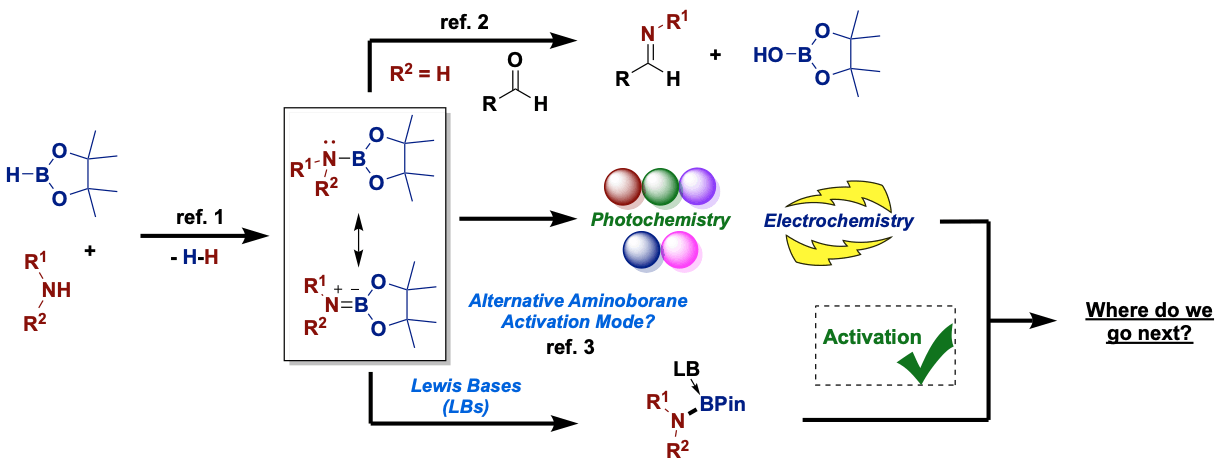Ongoing directions in the Romero group
Direction 1: Aminoboration reactions using isolable amino(pinacol)boranes as difunctionalization reagents.
Aminoboranes (R2N-BR2) are molecules comprised of a nitrogen and boron atom covalently coordinated. The N–B bond is further strengthened by π-donation from the nitrogen lone pair to the empty p-orbital on boron leading to an enthalpically favorable, partially sp2-hybridized bond that is hard to cleave. Since their discovery, aminoboranes have captivated chemists across a variety of disciplines. From a synthetic organic chemistry perspective, aminoboranes are reagents for polymer synthesis, asymmetric catalysts, and borylation or amination reagents. Until recently, aminoboration reactions were limited to reactions of diboron and hydroxylamine reagents under copper catalysis. Although exciting in the synthetic expedience, the stoichiometric waste products generated sustainability concerns. In 2016, Prof. Romero (then a graduate student) developed a broadly applicable dehydrocoupling reaction of amines with hydroboranes (HBPin and 9-BBN) to access numerous aminoborane derivatives (ref 1). He then applied the products to the formation of aldimines that cannot be accessed through traditional routes (ref 2). Since that time, only a single bona fide aminoboration reaction with these molecules was reported using butyl lithium as an activating reagent. As such, the hunt for an aminoboration reaction under mild conditions remains afoot. To facilitate our discovery of the first reaction at this end, we undertook a study elucidating the reactivity trends of amino(pinacol)boranes in the presence of neutral Lewis bases (e.g., pyridines, amines, phosphines, etc.) and under electro-/photochemical conditions (ref 3). Our results show that all three strategies are viable avenues to activate aminoboranes. With that, members of our team are working to apply these critical insights to designing the first mild aminoboration reaction. Will YOU be the one to find the next great reaction?
Our contributions to the field of aminoboranes:
1. E. A. Romero, J. L. Peltier, R. Jazzar, G. Bertrand. “Catalyst-Free Dehydrocoupling of Amines, Alcohols, and Thiols with Pinacolborane and 9-Borabicyclononane (9-BBN)” Chem. Commun. 2016, 52, 10563.
2. G. P. Junor, E. A. Romero, X. Chen, R. Jazzar, G. Bertrand. “Readily Available Primary Aminoboranes as Powerful Reagents for Aldimine Synthesis” Angew. Chem. Int. Ed. 2019, 58, 2875.
3. A. A. Braddock, G. E. Lee, E. A. Theodorakis, E. A. Romero*. "Interrogating Redox and Lewis Base Activations of Aminoboranes" Organometallics 2022, 41, 3845.


